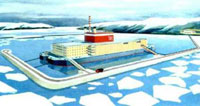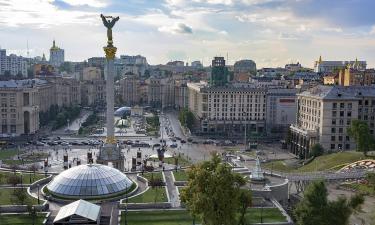Russia may become world’s leader in sea-based nuclear power stations
Russian atomic concern Rosenergoatom continues the construction of the first floating nuclear station (PATES). The project is supervised by the specially set up Directorship on Floating Nuclear Stations. Today it is obvious that Russia plans to focus on energy and floating nuclear stations are likely to have a high priority in the plans of the government. They are part of the federal purpose oriented program “Energy Efficient Economy for 2002-2005 and for the Perspective till 2010”. A complete cycle of operating a floating station will be ensured by the existing infrastructure of the Russian nuclear industry. At the same time Russia is restoring nuclear infrastructure of the USSR. This is done together with the Ukraine and Kazakhstan.

PATES was designed by the N.Novgorod based OKB Afrikantova, which has a number of floating nuclear stations with different power levels for different regions and climates. All are based on the reactors that had been for decades used on Russian nuclear subs and ice breakers. The smallest (3 MWt) costs just USD20m. Reloading nuclear fuel takes place once in 12 years. Lifetime is 50 years. Technologically the stations completely comply with the IAEA’s requirements of non-proliferation agreements. The head of Rosenergoatom Sergey Kirienko called the project “a breakthrough” and stated that Russia needs to build at least 7-10 such stations. It is worthwhile emphasizing that this is the world’s first project of a kind. The head station will be used for Sevmash itself. KLT-40C (the reactor of PATES) with 70mWt power is sufficient for supplying the energy to a town with the population of 50 000 people.
The project of floating stations first originated in Russia as an idea to heat the northern regions along the Arctic ocean. Today not only remote northern regions in Russia are interested in cheap and convenient supply of energy and heat. It can be used also as a station making fresh water of the sea water. Foreign customers and Asia and Middle East paid attention to the Russian development before Russia made the first station for itself. Traditional Russian partners in China and India with their growing economies demanding more energy are viewed not only as potential customers but probably even partners. Indirectly this was once confirmed during a meeting at Sevmash, where the president of Kurchatov Institute Evgeny Velihov drew attention to the opportunities of building international nuclear reactor. According to him it will be possible in 20s of this century.
Other participants of this project are: Atomenergo (St. Petersburg) – general designer, CKB Iceberg (St. Petersburg) – general designer of the floating energy block, Kaluga Turbine Plant (Kaluga) – general designer and supplier of steam turbine unit, NPO Avrora (St. Petersburg) – designer and supplier of automatic systems, PO Sevmash (Severodvinsk) – manufacturer of the floating energy block and general contractor. Officially confirmed characteristics of the station: length of the vessel -144 m; width of the vessel – 30 m; displacement – 21500 t; reactor – ship reactor KLT40-C (2 units); electric power – 70 MWt; heat power – 140 Gkal/hour; warranty period before manufacturer’s repair – 12 years; total lifetime – 40 years; staff – 69 people. The cost of the construction of the first PATES is 9.1 billion rubles. With the current energy prices the pay off period is about 10 years.
However, at the background of the success of this project it hasslipped from public awareness that Russia has a totally different project of the same kind, which could be at least as good. In fact floating nuclear energy was born in mid 90s and by 2000 such projects could have been implemented. Then the administration of Severodvinsk appealed to the Russian atomic agency with the proposals to consider arranging heat supply to the northern towns with the status of military bases using nuclear energy from the decommissioned subs.
At that time a group of specialists from Sevmash, Sevmashvtuz, White Sea naval base, NIPTB Onega and some other organizations had prepared a feasibility study and technical evaluation of the so called Korabelny Otopitel (ship’s heater), coded KOT. The initiative group consisted of over 20 specialists. The copies were sent not only to the atomic agency but to the technical dept of the Navy, a number of nuclear design bureaus (Rubin, Lazurit, Malahit), CNII Krylova, Kurchatov Institute, State Duma and other. Copies were sent to the administration of the regions which could be potentially interested in such stations: Bolshoi Kamen, Petropavlosvk-Kamchatsky, Polyarny and others.
The project was really feasible. The lifetime of the nuclear fuel on the subs decommissioned under the Nann-Lugar program was not finished, nuclear reactors were technically maintained. The arrangements with the US would not have been violated, because the subs would have been used solely in energy purposes. In fact Americans bothered only about destroying the missile silos of the subs. There had been several technical projects of using the decommissioned subs. In this way the subs had been used for years, for example, near the polar submarine bases. Once a sub in Gadzhievo was used to heat the freezing water pipeline. In Gremiha in 80s this practice was widely used. There aretechnical projects of passing the steam from the sub to the shore. However, all these projects were suspended on different stages of completion.
If used as a source of energy a decommissioned sub could earne considerably more in one season than the cost of its utilization. According to the member of the initiative group, Sevmash’s engineer on nuclear units M. Kotov, the efficiency of KOT is 74%. In one season it saves 1500-3500 rail wagons of coal. Also the safety was very high, because the reactors were designed for the armed forces and had to be very reliable in most difficult conditions. KOT was ready for implementation in 2000-2001. However, provincial Severodvinsk lacked efficient lobby, unlike its rivals in Moscow and St. Petersburg.
KOT had been patented before the talks and approval of PATES. The fact KOT appeared in the wrong time, during the messy period of late Presidents Eltsin, corruption with the state budget, certain fear of the so called West. According to the well informed sources of PravdaRu if PATES and KOT were contemplated today, when the situation in the country is stable and the leaders of the nation are free from western “friendly assistance”, in a tender between the two projects the chances of KOT would have been higher.
Unfortunately today it is difficult to implement KOT on a large scale in Russia. The subs of the project 667BD, 6677BDR, 667B and 670 / 671 were processed into needles with the American money. Today KOT could be of interest for the West itself. NATO, first of all US and the UK, have several tens of the decommissioned nuclear subs. The technical project of using them for civil purposes is not a secret.
Yuri Seleznyov
Subscribe to Pravda.Ru Telegram channel, Facebook, RSS!





